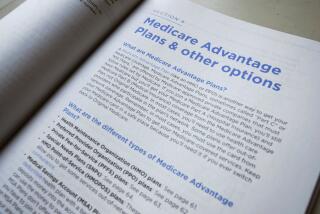Finding the right plan during Medicare open enrollment

Lynda Flathers of Chino says she’s happy with her current Medicare Advantage plan but wants to make sure that it’s still her best option.
It’s that time again for the nation’s more than 54 million people who get health coverage through Medicare to decide what they want in 2016.
Lynda Flathers just got a packet of information in the mail about changes to her Medicare Advantage plan for 2016. Although happy with her current coverage, Flathers wants to make sure that her plan is still her best option.
So she’ll shop during Medicare’s open-enrollment period, which got underway Thursday and runs through Dec. 7. Still, she’s a bit reluctant.
------------
FOR THE RECORD:
Healthcare Watch: In the Oct. 15 Business section, a healthcare column gave the wrong Web address for the Health Insurance Counseling and Advocacy Program, a free health insurance counseling program in California. The correct Web address is cahealthadvocates.org/.
------------
“It can be kind of confusing, and you just never know if you’re making the right decision,” says Flathers, a 65-year-old from Chino who works in fund development.
Medicare beneficiaries can change their Medicare health plans and prescription drug coverage during Medicare’s annual open-enrollment period.
Like Flathers, many seniors find shopping for Medicare Advantage and Part D prescription drug plans overwhelming.
Experts suggest steps to finding the right plan.
Don’t resist shopping. “Most people, once they select a plan, they tend to stay with that plan,” says Ronald Bolding, president of Pomona-based Inter Valley Health Plan. And that may be fine.
But the cost and benefit details of Medicare Advantage and stand-alone Part D drug plans change every year, so the plan that was the least expensive option in 2015 may not be for 2016.
“I do not remember a time when we did not make some kind of adjustment” to benefit designs, says Sherry Stanislaw, senior vice president with SCAN, a Medicare Advantage plan based in Long Beach.
Those changes can be costly. A recent survey of 49,000 people using eHealthMedicare.com to compare Medicare plans found that only 8% of those enrolled in Medicare Advantage and only 5% in a stand-alone Part D policy had the lowest-cost plan. Those who switched to a new Part D drug plan saved nearly $700 in 2015, and were 20% less likely to hit the prescription drug coverage gap.
Review all plan costs. Monthly premiums across all Medicare Advantage plans being sold in California for 2016 average $29.85. The highest premium is $221 per month, and the lowest is zero,according to an analysis by Health Pocket, a technology company that compares health plans.
Nearly half ofthe Medicare Advantage plans available for purchase in California will have no monthly premium at all.For prescription drugs, the average Part D premium in California is $61.78.
But averages are just that.
“Our big take-away is to look at not how has the market changed, but how has my plan changed with regard to the medications and services I use,” says Casey Schwarz, senior counsel for education and federal policy with the Medicare Rights Center.
That means looking beyond the monthly cost of your plan to examine all possible expenses.
“A lot of people use their premium to evaluate their plans, but that’s just one cost,” says Elaine Wong Eakin, executive director of California Health Advocates, a Medicare advocacy organization.
Carefully review the deductibles, co-pays and coinsurance you’ll be required to pay when you go for care. A plan with a low monthly premium may be more expensive in the long run if doctor visits or prescriptions come with high costs throughout the year, Wong Eakin says.
Review drug lists. Drug benefits in 2016 may be less generous in many plans as insurers increase costs, including deductibles and other out-of-pocket expenses.
Confirm that the medications you need are covered by your plan, and take time to understand the various rules you’ll need to follow.
According to the Kaiser Family Foundation, most plans place prescription drugs on at least five cost-sharing tiers. Generics on the lowest tiers cost the least, while brand-name and specialty drugs placed on the highest tiers come with the highest out-of-pocket costs.
The vast majority of drug plans also place pharmacies on tiers. You’ll pay less if you have your prescription filled at a pharmacy identified as one offering “preferred cost sharing.” Check carefully here, because not everyone lives near a pharmacy with preferred prices.
“If you can’t access one, don’t base your cost estimates on the preferred amount” listed for the medications you take, Wong Eakin says.
Confirm that your doctors participate in your plan. “That’s one of the things to evaluate when looking at a plan for the next year is whether your providers will be in network,” Schwarz says.
Going outside your plan’s network can be costly. A recent report by the insurance trade group America’s Health Insurance Plans found that out-of-network providers charged patients on average 300% more than Medicare rates for certain procedures and treatments, such as MRIs and chemotherapy.
Check star ratings. Medicare has a quality rating system in which plans are ranked from one to five stars, with five the highest.
Experts suggest choosing a plan with at least four stars, if available. Of the 37 Medicare Advantage plans offered in Los Angeles County for 2016, 19 received a rating of four stars or higher. Just four of the 25 stand-alone Part D drug plans earned four stars; none earned the top rating of five stars.
Flathers of Chino plans to attend a free community class about Medicare to help her sort through all the information.
“Knowledge is power, and the more knowledge and education you have on the subject, the better decisions you can make,” she says. “That’s what I try to do, and still I hope to make the right decision.”
Resources and links
To review your plan options: Medicare plan finder at www.medicare.gov or call (800) 633-4227.
For free personalized counseling services: State Health Insurance Assistance Programs: https://www.shiptacenter.org or call (800) 677-1116. In California, free counseling is available through the Health Insurance Counseling & Advocacy Program: caadvocates.org or (800) 434-0222.
Medicare Rights Center’s help line offers free counseling: (800) 333-4114.
Twitter: @lisazamosky






